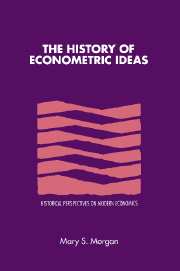Book contents
- Frontmatter
- Contents
- List of figures
- Preface
- Acknowledgements
- Introduction
- Part I Business cycles
- Introduction to business cycles
- 1 Sunspot and Venus theories of the business cycle
- 2 Measuring and representing business cycles
- 3 Random shocks enter the business cycle scene
- 4 Tinbergen and macrodynamic models
- Part II Demand analysis
- Part III Formal models in econometrics
- Conclusion
- References
- Index
2 - Measuring and representing business cycles
Published online by Cambridge University Press: 26 October 2009
- Frontmatter
- Contents
- List of figures
- Preface
- Acknowledgements
- Introduction
- Part I Business cycles
- Introduction to business cycles
- 1 Sunspot and Venus theories of the business cycle
- 2 Measuring and representing business cycles
- 3 Random shocks enter the business cycle scene
- 4 Tinbergen and macrodynamic models
- Part II Demand analysis
- Part III Formal models in econometrics
- Conclusion
- References
- Index
Summary
Clément Juglar, Wesley Clair Mitchell and Warren M. Persons used statistics in a different fashion from Jevons and Moore. These three economists believed that numerical evidence should be used on a large scale because it was better than qualitative evidence, but their use of data was empirical in the sense that they did not use statistical features of the data as a basis for building cycle theories. Further generalisations are difficult, because their aims differed: Juglar wanted to provide a convincing explanation for the cycle, Mitchell sought an empirical definition of the cyclical phenomenon, whilst Persons aimed to provide a representation of the cycle. The chapter begins with a brief discussion of Juglar's work in the late nineteenth century, and then deals at greater length with the work of Mitchell and Persons, whose empirical programmes dominated statistical business cycle research in the 1920s and 1930s.
The applied work discussed here grew in parallel to that described in Chapter 1, for Juglar was a contemporary of Jevons, and Mitchell and Persons overlapped with Moore. The developments that the three economists, Juglar, Mitchell and Persons, pioneered came to be labelled ‘statistical’ or ‘quantitative’ economics but never bore the tag of ‘econometrics’ as Moore's work has done.
- Type
- Chapter
- Information
- The History of Econometric Ideas , pp. 40 - 72Publisher: Cambridge University PressPrint publication year: 1990

